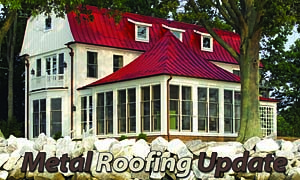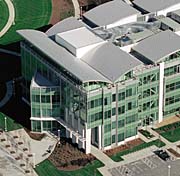

On the commercial side, a coalition of manufacturers, individuals and associations in the metal industry has launched an industry-wide program designed to increase the use of metal in the commercial construction market.
Known as The Metal Initiative (www.themetalinitiative.com), the coalition seeks to expand market share for its products through an educational and promotional strategy directed at building owners, architects, construction specifiers, consultants and contractors. The Metal Initiative's primary goals are to increase metal roof and wall market share by 25 percent; to achieve an increase of over 600,000 tons of steel, aluminum and copper; and to increase sales of metal products by $2 billion.
Of the MRA and the Metal Initiative, Jim Bush, vice president of sales for Atas International Inc., comments, "Between these two programs, and field-proven performance of metal, the industry will be seeing increases."
Entering the Market
One of the biggest headlines in metal roofing this year was Firestone's entry into the market with its acquisition of Copper Sales and its UNA-CLAD brand. Asked what prompted such a move, Mike Wallace, president of Firestone Metal Products, responds, "As the leader in the commercial roofing market, Firestone recognizes metal roofing as a complementary and synergistic product line that will result in greater overall sales growth."Firestone Metal Products will offer the roofing industry a full line of roofing products, vertical wall panel systems, and column cover products for the entire building envelope. Product choices include copper, painted steel and aluminum, stainless steel, bare galvanized, acrylume or the company's recent additions-RHEINZINK® and PatriotGreen™.
"The company also has a history of new product development," Wallace continues. "Progressive and innovative in nature, UNA-CLAD by Firestone will continue to expand to meet industry needs." Firestone Metal Products has more than 500,000 square feet of production space with facilities located in Anoka, Minn.; Jackson, Miss; Pompano Beach, Fla.; Morrisville, Pa; and its newest facility in Warren, Mich.

Cool Roofing, Sustainability
Big news all over the roofing industry is the trend toward cool roofing and environmentally conscious energy codes. How does this affect metal specifically?"Cool roofing is one of the fastest growing markets as energy efficiency impacts the decisions builders and architects make when selecting building materials," says Wallace. "Buildings consume one-third of all energy and two-thirds of all electricity generated, and the roofing system has a great impact on the energy use of the structure. As energy costs increase, metal roofing will continue to gain industry acceptance."
Wallace also notes that In addition to energy efficiency, metal roofing is recognized as a sustainable building material with a number of other environmental benefits. "The material's recycled content, recyclability, durability, and low weight-which allows it to be installed over old roofing systems-will continue to make metal roofing an environmentally friendly option for the construction industry."
Ed Thomas, vice president and general manager of Follansbee, Follansbee, W. Va., agrees. "Title 24 and other initiatives such as those by the MRA and the Metal Construction Association (MCA) are placing a strong emphasis on cool roofing, life-cycle costs and energy savings," he says. "These programs have really educated homeowners a great deal. This has helped position metal as a better option for the homeowner. Reviewing the data on life-cycle costs and energy savings and understanding those benefits has sparked the interest of homeowners when they might not have considered metal before."
"Metal roofing is stronger than ever. The increased demand for long-term sustainable roofing is helping to grow this market exponentially," adds Meredith England from Decra Roofing Systems, Corona, Calif. "We are finding a dramatic increase in the number of roofing contractors who are adding metal roofing to the products they offer in order to grow their businesses."
In terms of Title 24 specifically, England notes that the California energy code addresses roofing materials used on commercial buildings, specifically low-slope applications. "As the sustainability initiative continues to grow, we expect there will be standards for steep-slope roofing products and residential applications," she says. "Our continued focus on contractor growth and architectural specifications is driving our market."
Residential Outlook
"The metal roofing business is growing," says Neil Robinson, director of marketing for TAMKO Roofing Products Inc., Joplin, Mo. "Interest is high both at the homeowner level and at the roofer and design professional level. Storms over the last couple of years have encouraged the consumer to shift their focus to more premium high-end products. And most homeowners or property owners are willing to pay a little more to achieve the right look, performance level, and warranty for their home or business.
"TAMKO offers the complete line of METALWORKS® steel shingles. These products are available in three different looks-slate, wood, and tile. Even though these products have been on the market for quite some time, too often the homeowner automatically associates the category of metal roofing to a standing seam metal roof. Many homeowners don't realize that they have other options that can provide an aesthetically pleasing slate, wood, or tile look with steel shingle product performance. TAMKO plans to get this message out and lead the industry in promoting these products to the roofer, design professional, and consumer. And we will continue to develop new product designs and styles in the years to come."
Thomas reports that business for Follansbee has been steady overall.
"We've implemented a lead management program that forwards homeowner leads to distributors and contractors. This helps build our relationship with distributors and contractors and our lead management program allows us to be more responsive to sales leads."
New equipment is one focus at Atas. "We have installed some new state-of-the-art equipment on our product floor at our corporate headquarters: a new slitter and new bend center," says Tina Montone, marketing coordinator. "This equipment gives us better quality control of slit material, resulting in superior end product for the installers."
Delivery of metal roofing projects continues to move forward at a brisk pace. Innovations in coatings technology coupled with an increasing capacity to deliver finished materials and projects promise to keep the industry in the rapid-growth mode.
Roofing contractors continue to invest in state-of-the-art machinery to produce high-quality parts and fixtures. Continuous improvements of in-plant and jobsite panel forming machinery are gradually increasing productivity. As more roofing contractors enter the game, innovations on the installation side will no doubt continue to mount.
One thing is for certain. The marketplace demands what metal roofing has to offer: great looks, clean on-site installation, high energy-efficiency ratings, sustainability, and a high degree of recyclability. The future seems very bright for this growing segment of the roofing industry.
Report Abusive Comment